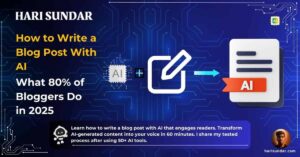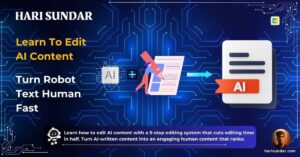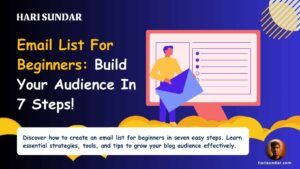Can Google Detect AI Content? A Blogger’s Truth (2025)
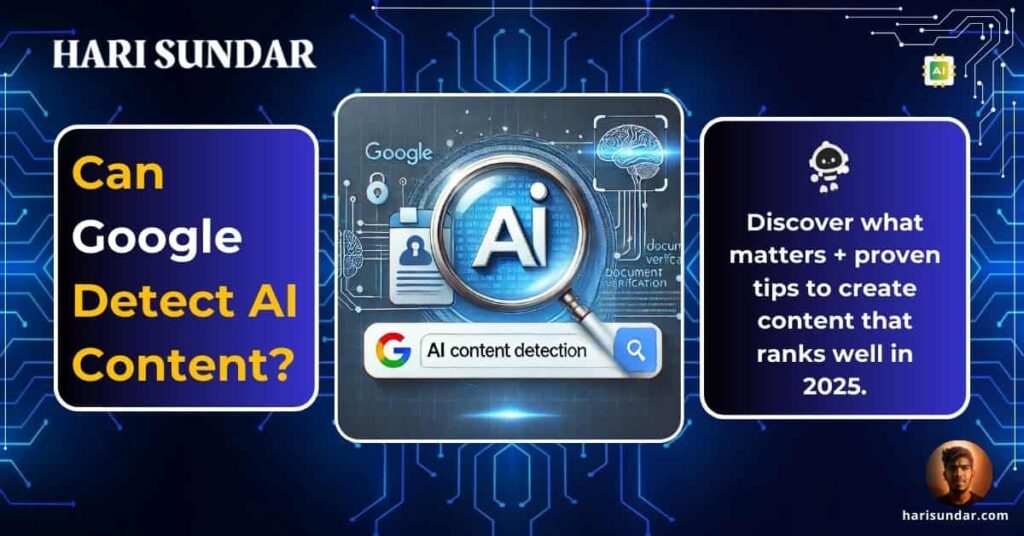
Last week, I ran the same blog post through five different AI detectors. Two said it was 100% human-written, two claimed it was AI-generated, and one crashed trying to decide.
It’s funny how everyone’s obsessing over AI detection when the reality is quite different.
Having tested numerous AI writing tools myself, I’ve discovered effective ways to improve and enhance AI-generated content while maintaining authenticity.
After running countless blog posts through various AI detectors and getting wildly different results each time, I realized we might be focusing on the wrong things.
According to Authority Hacker, 65.8% of people think AI content is equal to or better than human writing. Yet there’s still this constant worry about Google’s AI detection abilities.
Here’s what’s interesting – while you’re stressing about passing AI detection tests, Google cares more about whether your content helps readers than who (or what) wrote it.
So, can Google detect AI content? Let’s look at what Google says about machine-written content, and trust me, it might surprise you!
Here’s what you’ll learn in this post:
🔍 Google cares about quality, not how content is created
🔎 Why AI detection tools aren’t as reliable as you think
🚀 Real strategies from testing 10+ AI writing tools
⚡ How to make AI content rank well in Google
💡 Practical tips for blending AI and human writing naturally
Understanding Google’s Stance on AI Content
Google’s view on AI content is simpler than most people think. Based on my experience testing AI tools, I’ve created a comprehensive guide about using AI effectively in blog content that aligns with Google’s guidelines.
I’ve spent countless hours learning and testing various AI tools and studying Google’s statements on AI usage.
So far what I’ve seen is Google doesn’t care if a robot or human wrote your content, it mostly cares about whether your content helps readers solve their problems.
Think about it like cooking – you wouldn’t judge a meal just because someone used a food processor instead of chopping by hand. You rate the food only by how good it tastes.
Google takes the same approach with content. According to HubSpot research, 75% of marketers believe AI-enabled search engines will positively impact their blogs, showing growing confidence in AI content.
When you’re creating content with AI, Google looks for these key things:
- Experience: Shows you know what you’re talking about
- Expertise: Back up claims with facts and examples
- Authority: Link to trusted sources and research
- Trustworthiness: Be honest about your methods and sources

I’ve noticed many myths about Google’s AI detection floating around. Let me clear them up:
The truth is, that Google doesn’t have a magic tool that flags AI content. Instead, they use their helpful content system to spot low-quality content, whether it’s written by humans or machines. This system looks at factors like:
- How well the content answers user questions
- Whether it provides original insights
- If it includes first-hand experience
- The depth and accuracy of information
Focus on making your content genuinely helpful. From my testing, I’ve found that AI-written content can rank well if it:
- Addresses user needs clearly and directly
- Includes real examples and practical tips
- Gets fact-checked thoroughly
- Adds unique insights from experience
- Follows SEO best practices
Think quality beats the creation method every time. My content created with AI tools ranks well because I focus on adding value, not just generating words.
But here’s what many don’t realize – the game isn’t about fooling Google’s detection systems. It’s about using AI as a tool to create better content faster.
Ever wondered how detection tools actually work and if they’re reliable? Let’s see that in the next section.
The Current State of AI Content Detection
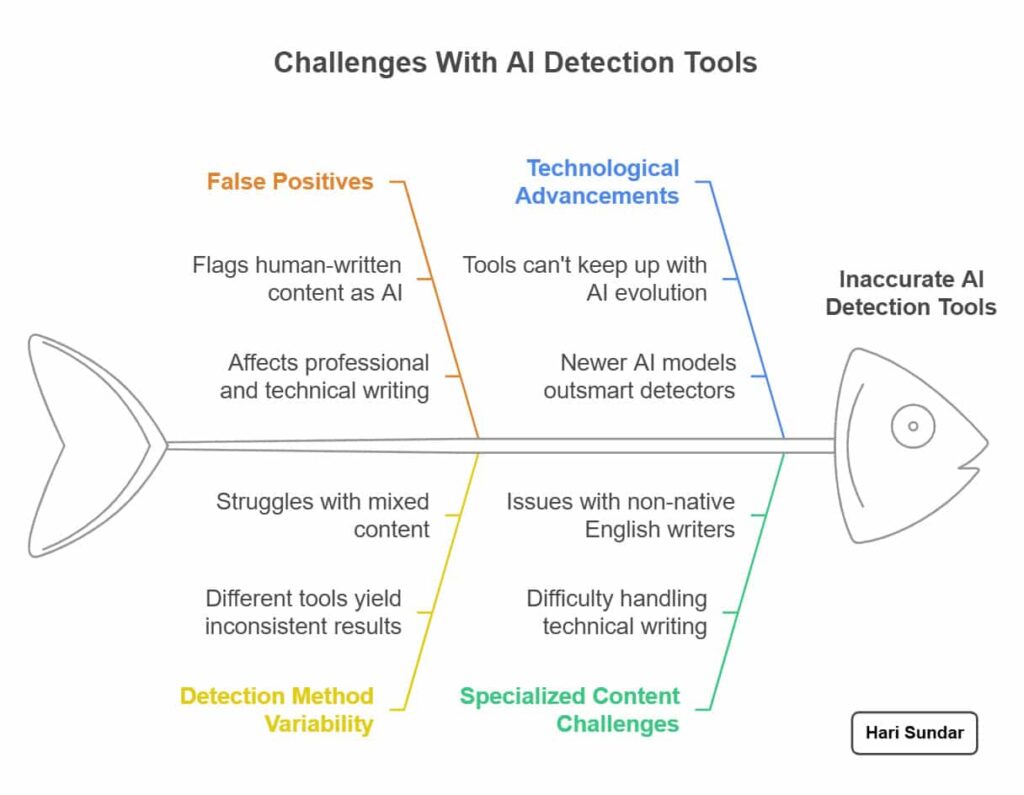
After trying out a bunch of AI detection tools, I picked up some useful info on how AI detectors spot and flag AI-generated content, along with their main drawbacks.
From my testing of tools like Content at Scale (now Brandwell), Originality.ai, GPTZero, and others, I’ve found something surprising – they’re not as reliable as many think.
Even OpenAI’s own detection tool only catches AI-written text 26% of the time. That’s like flipping a coin and getting it wrong three out of four times!
According to Authority Hacker’s research, 37.4% of marketers use AI detection tools, but many don’t realize how often these tools make mistakes.
I’ve tested hundreds of content pieces, and here’s what happens in real-world use:
- Detection tools often flag human-written content as AI-generated
- The same piece of content gets different results in different tools
- Even simple edits can completely change detection results
- Tools struggle with technical content and creative writing
Why is detecting AI content so hard? Think about it like trying to spot the difference between store-bought and homemade cookies. Sometimes you can tell, but often you can’t – especially if someone’s really good at baking. AI content works the same way.
Recent research from the NewScientist explains why perfect AI detection is mathematically impossible. It’s like trying to prove a negative – you can’t prove something wasn’t written by AI because AI can write in countless different ways.
From my testing experience, here’s what matters:
- Content quality matters more than passing detection tests
- Different tools give different results for the same text
- Even human writers get flagged as AI sometimes
- Detection accuracy drops as AI writing improves
I’ve found the most reliable approach is focusing on quality and authenticity rather than trying to beat detection tools. When I edit AI content, I usually do these:
- Add personal experiences and insights
- Include specific examples
- Back up claims with data
- Keep a natural, conversational tone
- Mix up sentence patterns and length
But here’s the real question – if detection is so unreliable, how are successful bloggers using AI to create content that ranks well? Let’s look at how they are creating content in the next section.
How Bloggers Are Successfully Using AI Content
The rise in AI adoption among bloggers has been incredible. Through months of experimentation, I’ve documented practical ways to write blog posts using AI tools without compromising quality.
I made many mistakes when I first started testing AI tools like ChatGPT and Claude for my blog posts. But those mistakes taught me what works and what doesn’t.
Recent data from Orbit Media shows that 80% of bloggers used AI in 2024, which isn’t surprising given how these tools can speed up content creation.
But here’s what’s interesting – successful bloggers aren’t just copying and pasting AI outputs. They’re using AI in smart ways that answer questions and solve problems.
I’ve found the most effective ways to use AI for blogging include:
- Writing first drafts quickly, then adding personal touches
- Creating detailed outlines to guide content structure
- Finding fresh angles for common topics
- Improving readability and flow
- Checking facts and statistics
What I have seen by testing different AI tools is that the best results come from using AI as a starting point, not the final product.
So, when you’re about to use AI to create blog content, follow these best practices below. It works perfectly in any niche.
- Start with clear, specific prompts
- Fact-check every statement
- Add real examples from your experience
- Keep your unique writing style
- Focus on solving reader problems
I treat AI tools like smart assistants, not replacements. One big mistake I see is bloggers trying to hide their AI use.
Instead, focus on making the content valuable. Whether you use AI or not, readers care about solving their problems.
But this brings up an important question – how do you turn AI-generated content into something Google actually wants to rank? Let’s explore the exact steps in the next section.
Creating AI Content That Google Loves
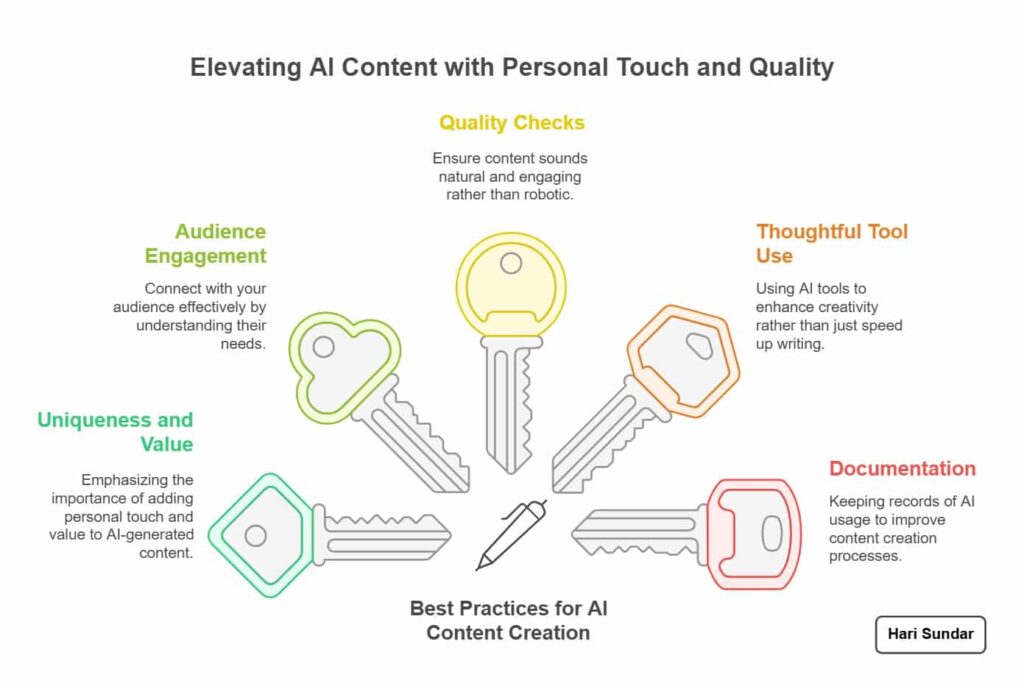
Over the years of working with AI tools for my content creation, I have learned how to edit AI content that transforms AI drafts into high-quality and engaging articles.
The key is understanding what Google really wants – content that helps people, not just well-written words. As noted by successful blogger Ryan Robinson,
“Most bloggers haven’t figured out quite what to make of AI yet. We’re seeing bloggers experiment with trying AI in everything, and those getting the strongest results have figured out how to weave these tools into their creation process in ways that save time while still keeping themselves—what makes their content truly special—front and center.”
So, Google wants to see your expertise shine through your content. When I write about digital marketing, I always add my real testing results and screenshots. This shows Google (and readers) that I know what I’m talking about.
The editing process is crucial. When I get AI-generated content, I do these:
- Add personal stories and examples
- Include recent data and research
- Remove generic statements
- Fix any factual errors
- Add unique insights from experience
I noticed that many bloggers make the mistake of using AI content straight from the tool. Instead, I treat AI drafts like a starting point.
Think of AI content like a cake mix. It gives you a solid base, but adding your own twist makes it unique.
When I talk about testing AI tools, I share real examples of what worked and what didn’t, so you can dodge the same pitfalls I did.
My top tip? Stick to what you know. When I write about AI detection tools, I show actual test results and screenshots. That way, readers get real insights they won’t find anywhere else.
And don’t forget to double-check what AI spits out. I once caught an AI tool making up stats about blog traffic, so now I make sure to verify every number and claim before I hit publish. This little extra effort keeps your content reliable and useful!
Conclusion
So, can Google detect AI content? The answer isn’t black and white, but one thing’s clear – focusing on quality beats worrying about detection.
To implement these strategies effectively, learn how to rank AI-generated content successfully in search results.
After months of testing and experimenting, I’ve found that success with AI content comes down to how you use it, not whether you use it.
The real win isn’t in trying to fool Google – it’s in creating content that genuinely helps your readers.
Ready to improve your AI content? Here’s your action plan:
- Start small: Pick one blog post and try adding your personal experiences to AI-generated drafts
- Test it yourself: Run your content through different AI detectors to understand their limitations
- Keep it real: Share actual results, case studies, or examples from your own work
- Make it yours: Add screenshots, data, or unique insights that only you can provide
- Check facts: Verify every statistic or claim the AI makes before publishing
Remember, AI is just a tool – like a really smart assistant who sometimes needs correction. Only your own knowledge and experience are what makes your content valuable.
Why not start today? Pick your next blog post and try these tips. You might be surprised at how naturally AI fits into your content creation process when you focus on adding real value instead of passing detection tests.
Hey, what’s your take on AI content? Drop your thoughts in the comments—I’d love to hear them!
FAQs: Can Google Detect AI Content
Can Google detect AI content?
No tool detects with 100% accuracy. While Google looks for content quality, they don’t have a perfect AI detector. Based on my testing, they focus more on how helpful your content is rather than how it was created. What matters is adding real value for your readers.
How accurate are AI content detection tools?
From my testing of tools like GPTZero and Content at Scale, they’re good but not very accurate. They often give different results for the same text and sometimes flag human content as AI-written. I’ve seen human-written content get flagged as AI and vice versa.
What happens if Google finds out I use AI for content?
Google cares about content quality, not the tools you use to create it. If you’re concerned about using AI safely, I’ve documented my testing results and created proven methods to write content that reads naturally. Focus on making your content helpful and valuable.
Will my site get penalized for using AI content?
No, Google doesn’t penalize sites just for using AI. They penalize low-quality content, whether it’s written by humans or AI. I’ve found that well-edited AI content with unique insights and real examples ranks just as well as human-written content.
How can I make AI content sound more natural?
To sound more natural, add your unique experience, your wins and failures, and include real data and examples. When I talk about marketing, I like to include the actual results from my campaigns, so that it makes the content unique and stand out, no matter if AI is used or not.
Is it okay to tell readers I use AI for content?
Yes, being honest is good. I’m open to using AI as a writing assistant. What matters is that your content helps readers solve their problems, whether you use AI or not.
How much should I edit AI-generated content?
From my experience, treat AI drafts as a starting point. Add your expertise, verify facts, and include personal insights. I usually spend more time editing and enhancing AI content than generating it.



